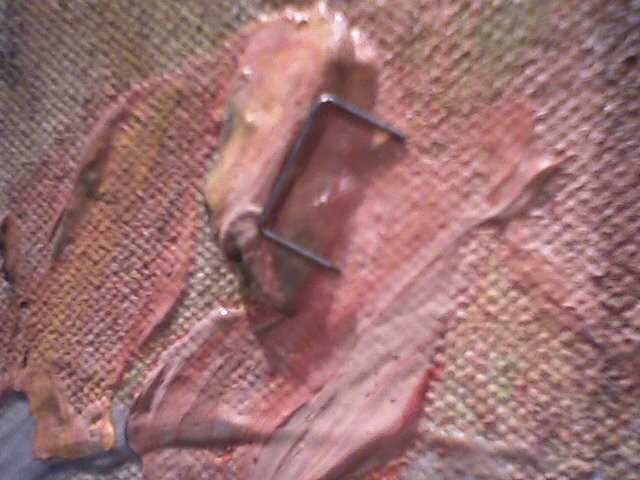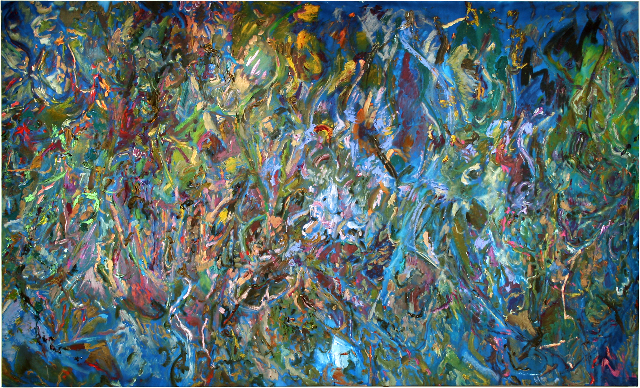Is it okay to call Larry Poons an Abstract Expressionist? I'm not sure. He's been around so damned long it's hard to say what he should be called -- he's outlived more movements than most people get to see in their lifetimes. I'm going to go ahead and call him an Abstract Expressionist because that's what he's doing now, I believe. If you see his most recent show at Danese and don't agree, well, you're blind. It looks to me like he's gone all the way around and back again and here he is, about 72 years old, not only still kicking but still working, and not only still working but still working at six feet by six feet, and working every inch of that canvas.
I won't say that the show bowled me over. But I was affected a lot more than I expected to be. Larry has that in common with Jackson Pollock, too -- I never expected Pollock to do much for me, but when I finally saw his work in person, wow, it knocked me back. Larry didn't hit me that hard, maybe because I don't sense that laser-like intensity of focus; rather, Larry's more meandering, questing. Maybe that's just because he's made it a lot farther than old Jackson ever did.
But I'm leading off with Pollock and Abstract Expressionism because Larry's latest show is rooted in that tradition. The works in this show are all large, all-over, tactile, almost scultped, and best viewed from that sweet spot where the painting just fills your field of view. Stand there and the world of the painter opens up to you. It's a world, in this case, filled with tentative marks, mostly right-handed dabs and strokes, mostly low-chroma, fleshy colors. The texture varies from mere stains on the canvas all the way up to thick oozing strokes, from grainy crumbles of nearly pure pigment to gluey translucent strands of almost pure acrylic gel. Every so often Larry dips into the brighter hues, whipping out a pink close to fluorescence or a deep sapphire blue.

Larry Poons at Danese, 2009, installation view: Check out the staple!

Larry Poons, Calling You, 2009, acrylic on canvas, 67.25x114 inches
Unlike the other paintings in the show, Calling You isn't painted on raw canvas, but instead is based on an underpainting of ultramarine. Ultramarine was once upon a time the most expensive pigment in the world, not just because of its rarity, but also because of its clear, ringing beauty. During the Renaissance it was often reserved for the gown of the Virgin Mary. Here Larry has used it as a powerful foundation, keeping this painting from quietly humming to itself like the others -- instead it sings. Across the field of blue his strokes play freely -- I'm mixing metaphors here. It's really not something to be described, only, as the best art should be, experienced.
If I say the show didn't bowl me over, that's all together; Calling You all by itself is absolutely fantastic. Make the trip to Danese for that alone.
Some people talk as if past art movements and styles are settled, done, and dead. But on the wall they're just as alive as we want them to be. It takes someone like Larry Poons to come along and show us that truth.
[Note: I'd like to thank Alexandra Woodworth at Danese for getting me the JPEG and details for "Calling You".]


When I was in grad school many years ago Larry Poons was a visiting artist/critic. He went around to the studios of people who signed up.I did not sign up for a crit, I knew I would be wasting his time and mine as I was realest painter, he did not like realism at all. However my friend did and he did not understand one word Larry said. HE was rude, indifferent and from what I understand pretty honest in his critiques. I did go to the group crit which in which two painters would put up there work and be in the hot seat for two hours a piece. This one guy who thought he was hot shit was torn down to the size of a pea.In the end what I remember of it Larry Poons basically called him one of the most dishonest painters he had ever met in the last 15 years or something to that effect. That he should try something else with his work as what he was doing was not working and to easy, formulaic.Intense stuff. Those crits sometimes made people cry.Poons was real New York asshole but he was also very funny, candid and did not care what anyone thought of him. He did however manage to piss off every student in that room. I found it funny as he reminded me of Gracho Marx with more intense put downs.
My experience with painters of Larry Poons' vintage is that they're straightforward, no bullshit, witty, abrasive, opinionated jerks. That's why I like them.
wow, chris. this is the best review i've read of anyone lately. i could really feel the paintings, the room, and you as one. thanks for GREAT job.
Thank you very much.
Great review Chris. The only thing I'd suggest is to put the ending date for the shows you review somewhere in the text. That would help a bit, particularly if your review excites me so much I need to run right out to see first hand what you've written about :) Thanks again.
That's why I've got the link to the gallery Website up there near the top in the text.I don't know why I don't mention the show dates most of the time. Occasionally I do, but not usually. I guess I feel it breaks the narrative flow. But I could try to remember to throw it in there from now on. We'll see.